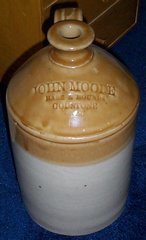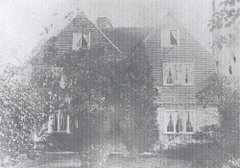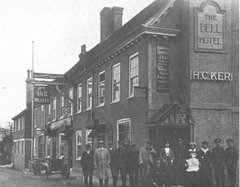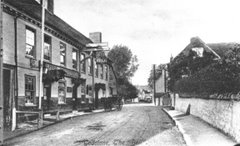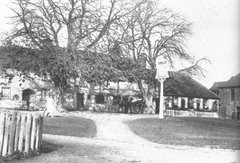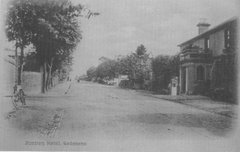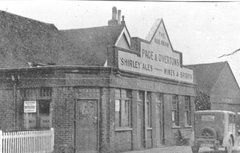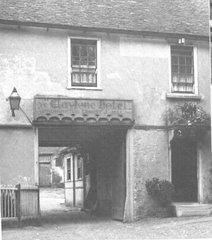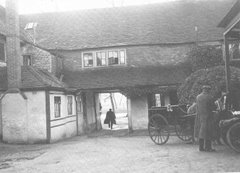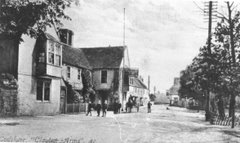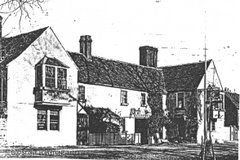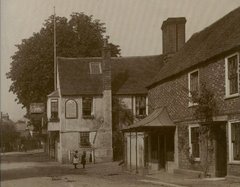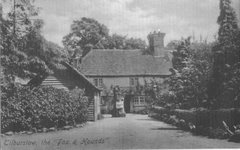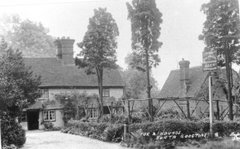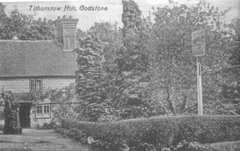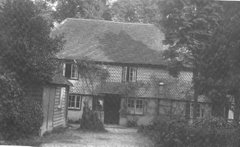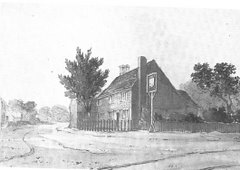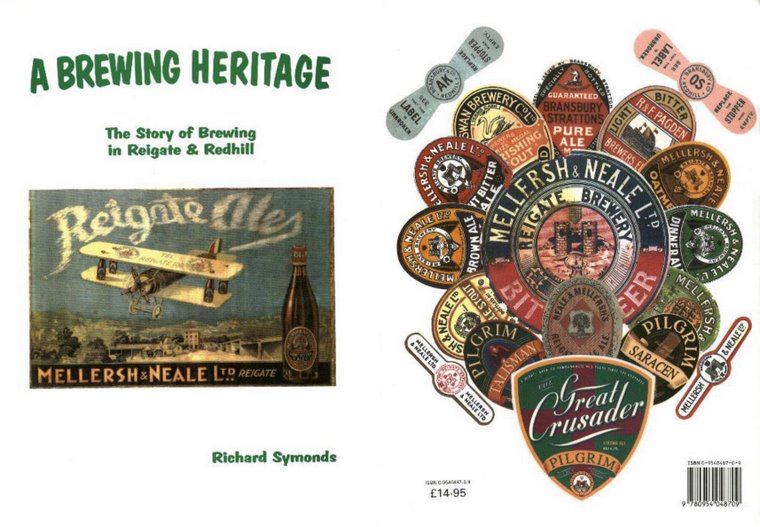A trade card of Edward Peters, Godstone Ale Brewery, has turned up on Ebay but described as circa 1895. This is incorrect as it is a much earlier relic - Edward Peters is listed as a brewer at Godstone in the 1839 Piggott's Directory. This is also confirmed in the 1841 census. However, by 1851 there is no longer any trace of the person nor of the concern.
Wednesday, 3 November 2010
Tuesday, 3 March 2009

I recently received an email from a Ms Penny Morris, who tells me that her great great grandfather G.H. Smith used to frequent the Clayton Arms in his cycling days for tea. it was run at the time by a Mr. Churchill, who he mentions in his history. "In those days the "Clayton Arms was run by Churchill, a fine specimen of mine host, old and white haired, yet straight backed, bright eyed and active. He dressed in rich brown velveteen and had a grand manner as well as appearance; one felt when there as if one were the guest of the Squire at some ancestral hall."
Tuesday, 24 July 2007
Further Info on Fox & Hounds, Tilburstow Hill

Fox & Hounds, Tilburstow Hill.
Built in 1358, this house has an inglenook fireplace, but is missing the fire-back (see posting under Whyte Harte, Bletchingley.)
The Fox used to be the haunt of smugglers who stopped there on their run from the coast to London. There was an incident in 1815, when smugglers were caught there by the King's Men, which was afterwards known as "The Tilbuster Battle".
Superstition proclaims that a hive of bees is lucky. Luck must certainly be in plenty at the Fox, for a hive remains there and history has proved that there has been a hive in the gable of the pub since the 1700's. (Surrey Pubs. Richard Keeble. Batsford press. 1965. pps 108/9)
Built in 1358, this house has an inglenook fireplace, but is missing the fire-back (see posting under Whyte Harte, Bletchingley.)
The Fox used to be the haunt of smugglers who stopped there on their run from the coast to London. There was an incident in 1815, when smugglers were caught there by the King's Men, which was afterwards known as "The Tilbuster Battle".
Superstition proclaims that a hive of bees is lucky. Luck must certainly be in plenty at the Fox, for a hive remains there and history has proved that there has been a hive in the gable of the pub since the 1700's. (Surrey Pubs. Richard Keeble. Batsford press. 1965. pps 108/9)
MISC Information on Bell, and Hare & Hounds pub

The Bell, Godstone.
The little grocers next door to the Bell used to be the Rose & Crown, where the grooms and the coachmen rested while the travellers stayed at the more luxurious Bell.
One night, in 1764, all the horses died from the poisoned water in the trough of the Bell; to this day it has not been discovered how the poison got there.
________________________________________________________
Hare & Hounds, Godstone.
One previous landlord used to be an undertaker and perhaps thinking of his days of the "wooden box" he named his bars the "oak bar" and the "pine bar"; For a while he conducted both trades at the same time, but had to give up undertaking as it tended to frighten his "live" customers away! Apparently, he used to walk about in a butcher's striped apron.
The little grocers next door to the Bell used to be the Rose & Crown, where the grooms and the coachmen rested while the travellers stayed at the more luxurious Bell.
One night, in 1764, all the horses died from the poisoned water in the trough of the Bell; to this day it has not been discovered how the poison got there.
________________________________________________________
Hare & Hounds, Godstone.
One previous landlord used to be an undertaker and perhaps thinking of his days of the "wooden box" he named his bars the "oak bar" and the "pine bar"; For a while he conducted both trades at the same time, but had to give up undertaking as it tended to frighten his "live" customers away! Apparently, he used to walk about in a butcher's striped apron.
Thursday, 28 June 2007
I have just been sent an email giving a little bit more about the Godstone Hotel.
"Built in the late 16th Century, when Elizabeth 1st ruled England. Designed originally as a coaching house, it was first known as the "Greyhound Inn" and most of the original timbers survive to this day, including the Inglenook fireplaces in the "Coach-House Restaurant" and "The Creamery".
During the Victorian period, and until as recently as the 1950's, the buildings were converted to a dairy farm known as Garston Farm (hence "The Creamery") Since 1976, this lovely old house has been owned and managed by Roy Howe. Now renamed Godstone Hotel, it once again provides food, refreshment and a place to stay for the passing traveller."
"Built in the late 16th Century, when Elizabeth 1st ruled England. Designed originally as a coaching house, it was first known as the "Greyhound Inn" and most of the original timbers survive to this day, including the Inglenook fireplaces in the "Coach-House Restaurant" and "The Creamery".
During the Victorian period, and until as recently as the 1950's, the buildings were converted to a dairy farm known as Garston Farm (hence "The Creamery") Since 1976, this lovely old house has been owned and managed by Roy Howe. Now renamed Godstone Hotel, it once again provides food, refreshment and a place to stay for the passing traveller."
GODSTONE PUBS & BREWERIES
GODSTONE.
The arrival of the railway did not have such an impact upon the population of Godstone as was expected. This was mainly due to the fact that the station was built about 2 miles from the village, and up to the first world way there was still much dependence on the horsebus or waggonette to get to the station. (Fairwell - Glorious Godstone).
GODSTONE BEER RETAILERS
1859. John Friend Everest, beer retailer & shopkeeper
1859. John Harrison, Tylers Green.
1859. Harry Rose, malster, miller & farmer. Godstone Mill.
1859. Henry Roffey, beer retailer, Felbridge, New Chapel.
1898. George Skinner, Tylers Green.
GODSTONE BREWERS
1839. Edward Peters (Piggotts)
1855. J Halifax (Post Office Dir.)
1871-1891. Alfred Churchill, Clayton Arms (Kellys)
Halifax, J.
Godstone
Dates: From 1855.
References: Post Office Directory 1855
Peters, Edward
Town: Godstone.
Dates: from 1839.
References: Piggots 1839.
Biographical Details: None available.
Churchill, Alfred.
Address: The Clayton Arms, Godstone Street,
Town: Godstone
dates: from 1871 to 1892.
References: Kelly’s Directories 1871 to 1891; 1892 Petty Sessional Returns.
Other Trading names: None
Acquired by: In 1892 the inn was owned by Sir W. R. Clayton of Harley Ford, Bucks, and presumably the name change was due to his acquisition of it. It was run as a free house. The licensee was Alfred Churchill. By 1898 the licensee had become Thomas J. Jell.
Biographical Details: The Clayton Arms was situated about 50 yards from the Bell and about the same from the Crown inn. It also lay about a quarter of a mile from the White Swan Inn. It was formerly the White Hart Inn and claimed to have been established in the time of Richard II, but the present building dates from the Elizabethan times, much of which is certainly 16th century. It changed its name between 1859 and 1871, for in the former year it is listed as the White Hart Commercial Inn and posting house, run by George Steer, licensee, vestry clerk, and surveyor of roads; In the latter year listed as the Clayton Arms Commercial Inn, run by Alfred Churchill, licensee and brewer. Churchill was brewing here from about 1871 until about 1892.
GODSTONE PUBS
Bell, Godstone Street.
Situated about 50 yards from the Clayton Arms and adjoining the Crown.
Much of the fabric of this Inn is 18th century and earlier, and is purported to be one of the oldest inns in rural Godstone still trading under its 15th century name.
Nalder & Collyer leased it circa 1855 (SRO 337/1/86). Uvedale Lambert in his Godstone records that in 1460 Joan, widow of John Kane, granted to her son a tenement called Le Belle, with a garden and croft called Emmesfield at Godstone; that in 1486 Sir Richard Harcourt left to his heir a messuage called Le Belle with 3 acres of land belonging; whilst in 1535 Randall Spurstone left to his son the Bell, yard and lands.
In the Whitgift Muniments of 1578 comes an entry of significance to Croydon. Richard Reade bequeathed the Bell to his wife Dorothy and also his house in Croydon called the sign of the Checker on the understanding that it was sold within 2 years of her death. In 1580 it was sold and again in 1591 when William Olyver bought it; in 1595 he sold the Checker to Archbishop Whytgift and it is part of the site on which Whitgift’s Hospital now stands.
Near to the Bell stood a tollgate for it is now on a narrow part of the London to Eastbourne Road. Showman Hughes, mentioned in the Victory story, paid a successful visit here, although compelled to play in the coach-house adjoining as the school authorities objected to comic songs.
There were alterations made by nalders, whilst in 1909 a fire gutted some outhouses which brought further rebuilding.
In 1959 the licensee was James Sherlock, and in 1892 the licensee was John Smith. The inn was frequented by labouring classes, and by 1898 the licensee was George W Ellis.
Tandridge council’s “Godstone Explores”gives the main frontage as dating from circa 1700, and the rear, with its crown post, as Godstone’s earliest existing building. A.Keeble in his book “Surrey Pubs” (1950s) wrote that in recent times Roman Catholic services were held at the Bell at 9.30am on Sundays.
The arrival of the railway did not have such an impact upon the population of Godstone as was expected. This was mainly due to the fact that the station was built about 2 miles from the village, and up to the first world way there was still much dependence on the horsebus or waggonette to get to the station. (Fairwell - Glorious Godstone).
GODSTONE BEER RETAILERS
1859. John Friend Everest, beer retailer & shopkeeper
1859. John Harrison, Tylers Green.
1859. Harry Rose, malster, miller & farmer. Godstone Mill.
1859. Henry Roffey, beer retailer, Felbridge, New Chapel.
1898. George Skinner, Tylers Green.
GODSTONE BREWERS
1839. Edward Peters (Piggotts)
1855. J Halifax (Post Office Dir.)
1871-1891. Alfred Churchill, Clayton Arms (Kellys)
Halifax, J.
Godstone
Dates: From 1855.
References: Post Office Directory 1855
Peters, Edward
Town: Godstone.
Dates: from 1839.
References: Piggots 1839.
Biographical Details: None available.
Churchill, Alfred.
Address: The Clayton Arms, Godstone Street,
Town: Godstone
dates: from 1871 to 1892.
References: Kelly’s Directories 1871 to 1891; 1892 Petty Sessional Returns.
Other Trading names: None
Acquired by: In 1892 the inn was owned by Sir W. R. Clayton of Harley Ford, Bucks, and presumably the name change was due to his acquisition of it. It was run as a free house. The licensee was Alfred Churchill. By 1898 the licensee had become Thomas J. Jell.
Biographical Details: The Clayton Arms was situated about 50 yards from the Bell and about the same from the Crown inn. It also lay about a quarter of a mile from the White Swan Inn. It was formerly the White Hart Inn and claimed to have been established in the time of Richard II, but the present building dates from the Elizabethan times, much of which is certainly 16th century. It changed its name between 1859 and 1871, for in the former year it is listed as the White Hart Commercial Inn and posting house, run by George Steer, licensee, vestry clerk, and surveyor of roads; In the latter year listed as the Clayton Arms Commercial Inn, run by Alfred Churchill, licensee and brewer. Churchill was brewing here from about 1871 until about 1892.
GODSTONE PUBS
Bell, Godstone Street.
Situated about 50 yards from the Clayton Arms and adjoining the Crown.
Much of the fabric of this Inn is 18th century and earlier, and is purported to be one of the oldest inns in rural Godstone still trading under its 15th century name.
Nalder & Collyer leased it circa 1855 (SRO 337/1/86). Uvedale Lambert in his Godstone records that in 1460 Joan, widow of John Kane, granted to her son a tenement called Le Belle, with a garden and croft called Emmesfield at Godstone; that in 1486 Sir Richard Harcourt left to his heir a messuage called Le Belle with 3 acres of land belonging; whilst in 1535 Randall Spurstone left to his son the Bell, yard and lands.
In the Whitgift Muniments of 1578 comes an entry of significance to Croydon. Richard Reade bequeathed the Bell to his wife Dorothy and also his house in Croydon called the sign of the Checker on the understanding that it was sold within 2 years of her death. In 1580 it was sold and again in 1591 when William Olyver bought it; in 1595 he sold the Checker to Archbishop Whytgift and it is part of the site on which Whitgift’s Hospital now stands.
Near to the Bell stood a tollgate for it is now on a narrow part of the London to Eastbourne Road. Showman Hughes, mentioned in the Victory story, paid a successful visit here, although compelled to play in the coach-house adjoining as the school authorities objected to comic songs.
There were alterations made by nalders, whilst in 1909 a fire gutted some outhouses which brought further rebuilding.
In 1959 the licensee was James Sherlock, and in 1892 the licensee was John Smith. The inn was frequented by labouring classes, and by 1898 the licensee was George W Ellis.
Tandridge council’s “Godstone Explores”gives the main frontage as dating from circa 1700, and the rear, with its crown post, as Godstone’s earliest existing building. A.Keeble in his book “Surrey Pubs” (1950s) wrote that in recent times Roman Catholic services were held at the Bell at 9.30am on Sundays.
___________________________________________________________________
Blacksmiths Head, New Chapel.
Situated about 2½ miles from the Blue Anchor and about 1 ½ miles from the Greyhound, Lingfield.
The name is a comparatively recent innovation, as in 1892 it was only an off-licence named New Chapel, owned by the executors of Lord Cottenham’s estate and run as a free-house by Philip Figg. Patronage was mainly by local cottagers.
___________________________________________________________________
Hare & Hounds, Godstone Green.
Situated about ¼ mile from the Clayton Arms, and 250 yards from the White Swan. The inn dates from the 18th & 19th centuries, but the coach-house is 18th. Formerly owned by Sir W. R. Clayton, it was run as a free house. The licensee in 1892, was John Moore, whose forbear, William, had it in 1859. There was stabling for 3 horses and the inn was frequented by tradesmen and working classes. By 1898 the licensee had become Mrs Elizabeth Moore.
___________________________________________________________________
Railway Arms, Godstone Station.
Situated about 2 miles from the Blue Anchor and about 2½ miles from the Bell. Owned by Pagdens of Epsom, it had stabling for 12 horses.
In 1859 the licensee was Henry Mills, listed as being at the Railway Inn, and also described as farmer.
In 1892 the licensee was James Durtnall Charlton and the inn was used by railway travellers and others. J D Charlton was still there in 1898.
___________________________________________________________________
Rose & Crown, Godstone Street.
The building dates from the 16th century, but is mainly 17th . It lies on the west side about 50 yards from the Clayton Arms and adjoins the Bell.
By 1839 it had already become a coaching inn, with the “Globe” London to Brighton coach, and also the Eastbourne coaches stopping here.
Nalders leased the property circa 1858 (it became freehold in 1883), along with a cottage, wheelwright shop and full use of a pump (SRO 337/1/86). The licensee was George Reading. It housed the coachman and groom of the masters who stayed at the Bell Inn next door (A.Keeble, Surrey Pubs) and it became a mecca for many of the parties that came in brakes and was the scene of many brawls (Fairall- Glorious Godstone).
By 1892 the licensee was Charles Miles and the inn had descended into a working class drinking den. By 1898 the licensee was C A Berry.
Today the 19th century tile & brickwork building that houses a 15th century timber-framed core, is home to Compton’s the insurance brokers, the inn having closed down. There is a Nalder & Collyers boundary plate in the forecourt, which in itself is a remarkable survival. As many pubs have now lost their boundary plates, here is a boundary plate that has lost its pub!
___________________________________________________________________
The Star, Felbridge
Situated at New Chapel on the mail road to East Grinstead, about 3¾ miles from the Blue Anchor and about 1¼ miles from the Railway Hotel, East Grinstead. The building is 18th century but much restored, and was frequented by agricultural labourers.
In 1859 it was run by Elizabeth Sanders.
In 1892 it had a full licence but only a 6 day licence, closing one hour earlier than other inns. It was owned by Charles Henry Gatty of Felbridge Park, and was run as a Free House by Jesse Garman.
___________________________________________________________________
Blue Anchor, Blindley Heath.
Situated on the main road to East Grinstead about 2 miles from the Railway Hotel, and 2½ miles from Lingfield Hotel.
Originally 15th century but much restored.
In 1859 the licensee was Richard Scott
In 1892 it was owned by John Dashwood of the East Grinstead Brewery, but later by Page & Overton. The licensee in 1892 was Arthur George Worsell and the inn was frequented by labouring classes and dealers. By 1898 the licensee had become John Lawrence Knell.
___________________________________________________________________
Clayton Arms, Godstone Street.
Situated about ¼ mile from the White Swan, 50 yards from the Crown, and about the same distance from the Bell.
It was formerly called the White Hart and claims to be established in the time of Richard II, but the present building dates from the Elizabethan times, much of which is certainly 16th century. It changed its name between 1859 and 1871, for in the former year it was listed as the White Hart Commercial Inn and posting house, run by George Steer, licensee, vestry clerk and surveyor of roads; and in the latter year listed as the Clayton Arms Commercial Inn run by Alfred Churchill, licensee and brewer. Alfred Churchill was brewing here from about 1871 until 1892. The Inn’s sign bears the Hart on one side, and the arms on the other.
It is said that Cobbett often lunched here, and probably the inn-parlour where he had his bread and bacon is very much the same as when he wrote of the village in Rural Rides. Perhaps the rooms upstairs held more furniture than now - particularly the fine dining room with its oak-beamed ceiling which is as full of furniture as a room can very well be, besides serving various public uses as a place in which audits and meetings are held and county and local account books are inspected. In fact, in the 17th century the Board of Guardians used to meet here every Friday during the winter and once a fortnight in the summer. In the yard outside too, although the great vats of the brewhouse are gone and cars are driven under the arch which used to echo to the shoes of spanking teams, there can be little changed since Cobbett saw it.
On the courtyard wall stands a quaint notice: “Any person seen smoking in the stables will be fined 5/- by the landlord”; but when the landlord first decided that stable-boys and grooms must not smoke is beyond recollection.
Much else outside the inn is unchanged. Cobbett wrote in 1822 “At and near Godstone the gardens are all very neat; and at the Inn, there is a nice garden, well stocked with beautiful flowers in the season. I here saw last summer some double violets as large as small pinks and the lady of the house was kind enough to give me some of the roots.”
In 1892 the inn was owned by Sir W R Clayton of Harley Ford, Bucks, and presumably the name change was due to his acquisition of it. It was run as a free house the licensee being Alfred Churchill. By 1898 the licensee had become Thomas J Jell.
____________________________________________________________________
Fox & Hounds, Tilburstow Road.
Situated 1½ miles from the Clayton Arms and 2 miles from the Blue Anchor. This 16th & 17th century inn was sometimes described as a roadside Inn at Stanstead Borough.
Owned in 1892 by Bushell & Co of Westerham. The licensee was Harriett Goff, and the inn was frequented by labouring classes. Hariett Goff was there until 1898.
__________________________________________________________________
White Swan, Godstone Green.
Situated ¼ mile from the Clayton Arms and 250 yards from the Hare & Hounds. It also lies about ¼ mile from the Old Surrey Hounds.
This early 18th century building was formerly the Godstone Poor House. It had a varied career, successively becoming a Dame School, then a lodging house, and around 1868, when it housed navvies working on Marden tunnel, it had its share of brawls. It was conveyed, freehold, to Nalder & Collyers, brewers of Croydon, in 1888.
In 1892 the licensee was Charles Edward Stevens and the inn was frequented by working classes. By 1898 the licensee had become Edward Mills.
____________________________________________________________________
Old Surrey Hounds, Caterham Road.
Situated ¼ mile from the White Swan and about 2½ miles from the Railway Hotel, Caterham.
In 1892 it was a beerhouse owned by Ludlam & Grant of Shirley and run by Jesse harbour. It was frequented by labouring classes.
____________________________________________________________________
Godstone Hotel,
Situated opposite Comptons Insurance brokers, formerly known as the Greyhound, and more recently as Garston farm. The building dates from the late 16th century.
____________________________________________________________________
Old Packhorse Inn, Church Lane
Now a private dwelling called the Old Pack house. This building dates from the 15th & 16th centuries. It has a picturesque timber-framed building reminiscent of a 15th century hall-house.
____________________________________________________________________
Iron Pear Tree, Tilburstow Hill.
According to the Bourne Society Local Records there stood an 18th century beerhouse on Tilburstow Hill about 2 miles outside Godstone village. Here also stood a mineral spring at one time of great repute.
Tradition has it that a pear tree stood in the garden of this ale house, which always bore a good crop. However, the pears were so hard that no-one could eat them so it becale known as the iron pear tree. A landlord named Bonwick, who suffered terribly from the Gout, sunk a well next to the tree from which he could draw water to make his own beer. After drinking his own brew he was suddenly cured. However, the locals refused to drink the beverage thinking there was some kind of witchcraft involved.
"In majesty Iron Peartree stands,
And has welcomed people from many lands.
A whisky and a soda, and a tot of gin,
It was first a humble country inn.
And so the centuries were passed on,
Wells were dug and then anon.
Iron was found and bottled tight,
Then sent to London by coach at night."
Thus a jockey named Prentice, who resided with the brewster at the alehouse, saw the potential such a beverage could bring, so he bottled some up, took it to London, and sold it for sixpence a quart. Its healing qualities for gout as well as "bilious and other disorders" must have been believed, as his trade grew by leaps and bounds.
The Evening Post of 1752 printed thet Iron Peartree water was despatched to London 3 times a week in 2 and 3-gallon jars and could be bought at the premises of Mr Davis, Purveyor of water to His Majesty; in St Alban's Street at Mr Eyre's Mineral Water Warehouse at Temple Bar, and at Mr Cartwright's behind the Royal Exchange at the George Inn in Southwark.
Sufferers were encouraged to visit the Iron Peartree ale house in deepest Surrey, where they could sample the famed waters at the well itself, from a man named William halcombe, or alternatively at the White hart at Godstone, from Henry Baldwin who sold it at a shilling a bottle - one half the price in London.
There was a fiddle, of course, because anyone who chose to visit and made a bulk purchase, was charged an inflated price of two shillings & sixpence for a 3-gallon bottle and two shillings for 2-gallons. A deposit was given back if the empties were returned, however.
The last reference to waters from the Iron pear Tree was 1779, when a villager named Russell who had suffered from gout since the age of 12, "had a mind to try the effects of the water and got the well opened, being after Christmas, to drink the water and had no fit in that year, and continuing to drink it at times, had none ever after." One can infer from this story that the well had fallen into disuse at some time earlier, and he must have been suffering quite badly to go to such lengths to alleviate the pain.
It is understood that surviving bottles fetch considerable sums of money, one, found as far afield as India, recently fetched £1,400 in auction.
Subscribe to:
Comments (Atom)


